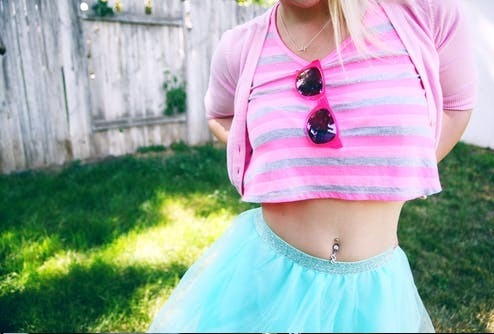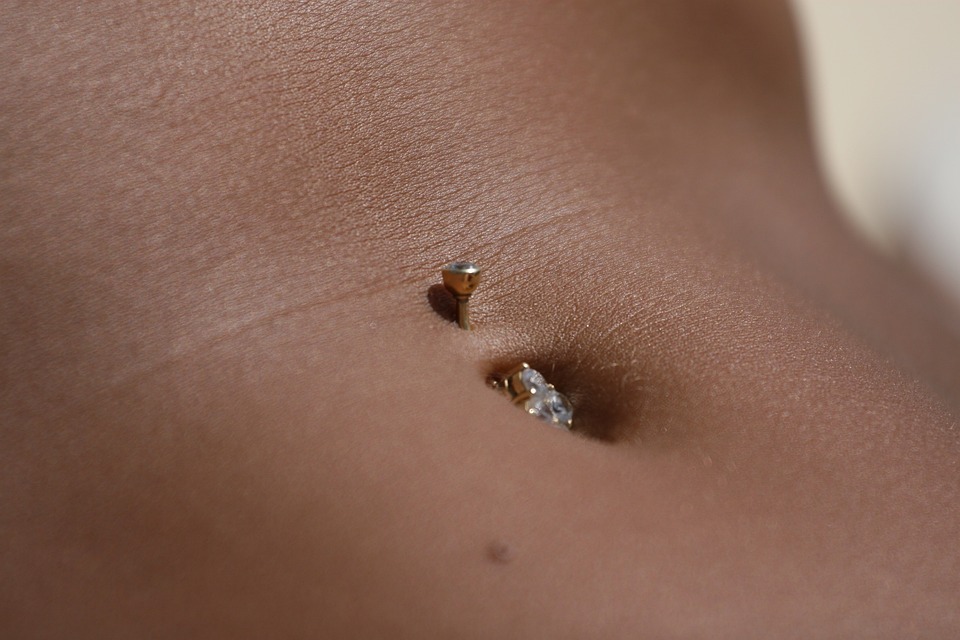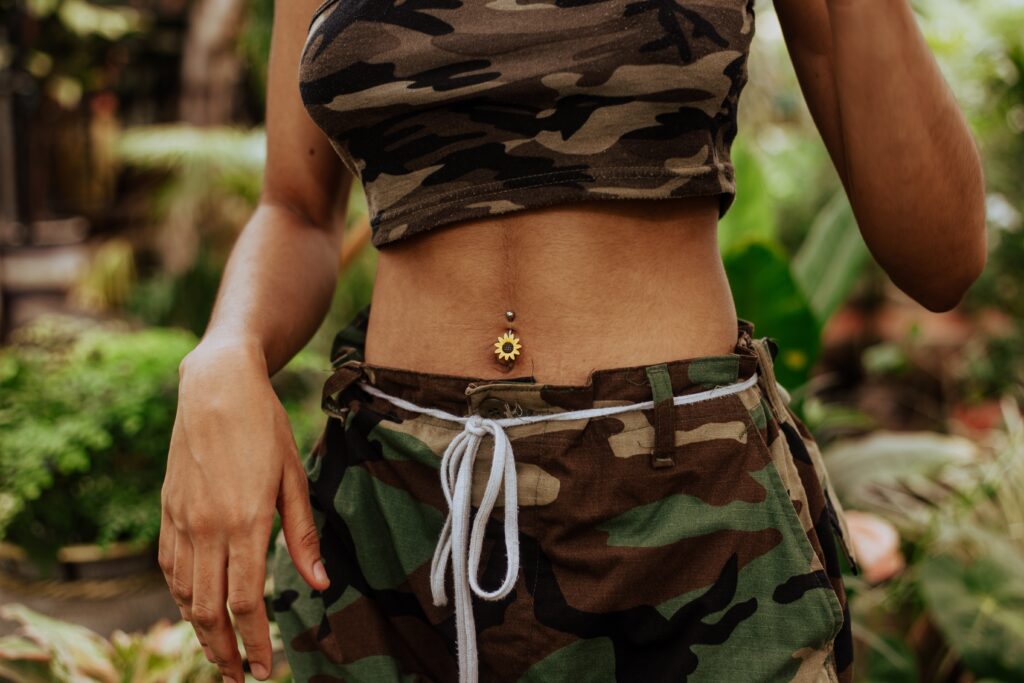Belly button piercing rose into popularity in the 1990s after renowned pop stars and divas gave this type of piercing mainstream exposure. Since then, it has continued to gain the interest of many people who do it for style, aesthetic values, or as a form of self-expression.
If you’ve decided or are thinking of getting one, it’s great for you, as having a new piercing is always a delightful event. After all, there’s nothing cuter than seeing a curved barbell or a titanium ring popping out of your navel and complementing your look.
Though a belly button piercing is a wonderful addition, just be mindful that extra effort is required for its aftercare to ensure it won’t suffer from rejection, infection, and migration. To do that, explore this article as we’ll provide all the information you need about the proper aftercare routine, leading to a quicker recovery of your navel piercing. Body piercing has different types and the most common ones are nose piercing, ear piercing, and belly button piercing.
What Is A Belly Button Piercing?
As the name says itself, this type of piercing jewelry is inserted around your navel or belly button. Typically, it’s done about ½ to 1 inch above the navel, traversing down and peeking out the upper lip of the belly button cavity. The standard outturn is the bottom ball of the ring sitting inside or on top of your umbilicus.
If you have an “outie” belly button where the skin of the navel protrudes and gives a “knot” appearance, you can still have a belly button piercing, but the placement of the ornament may vary, though not significantly. That won’t be an issue, given that many people also opt to have their piercing done at different angles, from the left, the right, or from the bottom.
With that, belly button piercings remain a stylish, versatile form of body modification that offers a fascinating array of jewelry options to choose from bent barbells, bead rings, dangle charms, and many more. Aside from being able to match your body type or style, you can also easily conceal it under clothing, allowing you to wear it even at work or in other professional settings.
As always, remember that you should know the precautionary steps to take, the process of piercing, and the pain you have to endure before visiting a piercer.
Belly Button Piercing Safety
Whenever you decide to get a navel piercing, don’t miss to steps to avoid issues:
1. Know your piercer and choose one with care
Having a license that necessarily equates to excellent service and experience, which are vital aspects when selecting a piercer. You may want to ask how long they have been in the industry, how they learned, and what training they’ve undergone and are planning to take to improve. Check also if they’re adhering to the best practices and taking the necessary actions to ensure their customer’s safety. A good piercer will always be happy to talk about their qualifications, the procedure, and your utmost safety.
2. Pick a salon you trust
Try to find a salon that you can trust. Visit the location ahead of time so you can get a feel of their shop. Ensure their place is clean and sanitary with good lighting so your piercer can clearly see what they’re doing. Their licenses should be displayed visibly on the wall so their customers can easily see them. Meanwhile, you can also ask for recommendations from your family, friends, or colleagues, given that word of mouth is usually the greatest way to find a trustworthy, reputable piercing parlor.
3. See to it that the needles are sanitary
Take note that all piercing needs must be sealed in sterile pouches, ensuring that they haven’t been used by anyone else. Sharing needles is a big no-no, as it can expose you to bloodborne diseases like HIV, Hepatitis B, and Hepatitis C. If your piercer is using a disposable needle, ask for a fresh one from a sealed package. Plus, your piercer must also always wear disposable gloves at all times.
4. Be picky about the jewelry
Be careful when choosing your jewelry. Your safest choice will be ones made of medical-grade stainless steel, as they are less likely to cause nasty allergic reactions. Alternatively, you may opt for niobium, titanium, or gold (14 karats and above). Skip cheaper jewelry made of lead or nickel that can trigger terrible allergic reactions. Also, ensure that the ornament you pick is free from irregular surfaces, sharp edges, scratches, or nicks, which can tear your skin and increase your risk of infection.
Process of Belly Button Piercing
When you visit the piercer, he or she asks you to lie down in a relaxed position. Before piercing, a piercer disinfects the place of piercing and, after that, marks a spot where they would puncture an opening. You may tell him or her where the piercing should be done. Your pierce will then use a hollow needle to create an opening where to insert your chosen jewelry.
You will experience pain and bleeding. The piercer will take care of it and clean it. But the process doesn’t stop here. The healing process takes time, so you should follow all the belly button piercing aftercare instructions.
Why is Belly Button Piercing Aftercare Important?
Piercing aftercare is very important because even if the process of piercing goes smoothly, you have to take care of it until it is healed. The healing period of belly button piercing is almost nine months to a year.
Though flesh piercings generally heal faster than ones done in the cartilage, constant movements in their placement location in the abdomen make healing longer to heal.
While you may be remaining still or just sitting, small twists or turns move the jewelry in your belly button causing it to snag and prolong healing times. Not to mention that the navel also tends to trap and lint that increases risk of infection, which can further lengthen the recovery process.
That’s why proper belly button piercing aftercare is important, as these steps can promote quicker healing and keep your belly button healthy!
Belly Button Piercing Aftercare
Your piercer should guide you about everything you should do until the piercing is completely healed. Some aftercare products will be recommended by your piercer that contains ingredients that won’t irritate.
For the initial stage of belly button piercing aftercare, sprays are recommended because they are gentle to use. You can use NeilMed piercing aftercare spray on the area of the piercing 2-3 times a day to reduce the time of healing.
Here are some precautionary measures to take to further shorten the healing time:
1. You shouldn’t touch your piercing
Except when cleaning, never touch, turn, play, or fidget your piercing. Avoid also applying anything on your skin that could reach or get into the area, such as lotions, perfumes, essential oils, and other chemicals that can irritate the pierced area.
2. Wear loose or baggy shirts
Tight clothing will rub against your piercing and trap bacteria, lengthening the healing process. Wear loose-fitting apparel or go shirtless (if possible) to protect and minimize irritation in the area.
3. Keep your piercing clean
You may see an off-white or yellow-colored fluid oozing of the pierced area during the first few days after the procedure. It may form crusts, but don’t panic as this is the body’s natural response to the new object in your belly button.
Never pick the crust no matter how itchy or tight it may feel. If you do, it will cause the pierced area to bleed. Allow the crust to naturally come off as the area heals.
What you need to do instead is keep the area clean daily. After washing your hands, clean the area using warm water and a small amount of soap for about 30 seconds. Rinse thoroughly afterward. Then, soak the area under sterile saline solution for about 5 to 10 minutes. Lastly, pat dry using disposable, soft paper products.
4. Avoid its contact with water
Stay out of hot tubs, swimming pools, rivers, oceans, and lakes. These places may harbor bacteria that can come into contact with your wound and lead to infection.
5. Use gentle hands for any application
Clean the pierced area with gentle force to avoid irritation. Avoid also cleaning it too much or too often. That won’t help quicken healing, but instead cause the recovery process to regress.
6. Use non-irritating sprays or creams
Only use recommended, non-irritating sterile saline solution or creams recommended by your piercer or dermatologist.
7. Make sure you are not allergic to the piercing jewelry
Healing won’t happen if you’re allergic to the jewelry itself. Be mindful that allergy to metal can happen by simply touching your skin. For piercing, reactions tend to be more pronounced as the metal is passing through the skin. There’s no permanent cure for jewelry allergy. The best thing to do is to avoid the metal itself.
Other Do’s and Don’ts While Healing
Do’s
- Take care of your overall health. Drink vitamins, sleep adequately, and eat well. The healthier you are, the better your immune system, and the faster the healing process.
- Avoid overexposure of the pierced area to the sun.
- Should it occur, you can use an ice pack to reduce the swelling.
- Ensure that all products like soap, shampoo, and conditioner are rinsed away thoroughly from the pierced part.
Don’ts
- Sleep on your stomach. This can cause too much pressure on the area and cause pain and discomfort, and slow down healing.
- Scratch the pierce part. If it’s itchy, you can calm the itchiness by applying ice inside a clean pack or bag.
- Keep the wound covered with bandages. Such will restrict airflow, catch moisture, and trap bacteria that can lead to infection.
- Stretch or pull your stomach that can cause the jewelry to move.
- Change the jewelry until it’s fully healed. To be sure, visit your piercer to checking for approval if you can already change the initial jewelry.
Precautionary measures
You have to take some precautionary measures if you want to reduce healing time.
- You shouldn’t touch your piercing
- Wear loose or baggy shirts
- Keep your piercing clean
- Avoid its contact with water
- Use gentle hands for any application
- Use non-irritating sprays or creams
- Make sure you are not allergic to the piercing jewelry
When to seek medical assistance?
If you don’t follow the instructions, then you might end up increasing your pain and infecting the area or piercing. Other than infection, swelling, bleeding, and scarring can also occur. So, make sure to take care of belly button piercing.
Also if you feel any irritation, you should seek medical help to see if the products you are applying are not suitable for you or if you are allergic to the jewelry. There are chances of complications but it’s not like you should get scared of it. You should take safety measures so that there is no chance of infection.
Conclusion
The process of piercing is short but you should follow all the aftercare instructions for a quick recovery. Belly button piercing is very famous in the west. So, anyone who is interested in belly button piercing or any other piercing should study it. If you don’t have time for aftercare, you shouldn’t go for a piercing. Because you might end up complicating things. Some of the aftercare instructions are mentioned above but you should also visit a piercer to know all about piercing and its aftercare.



